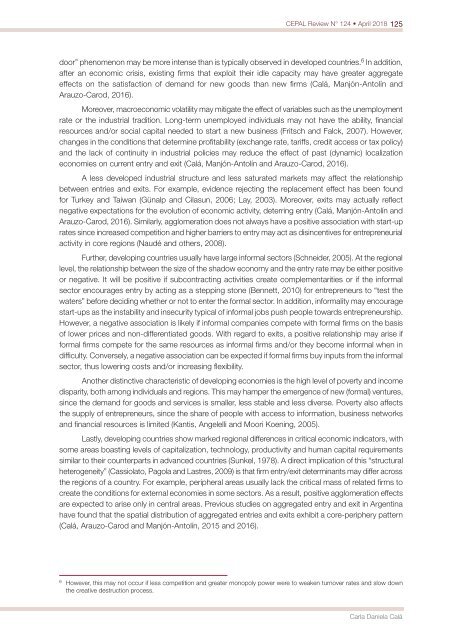CEPAL Review no. 124
April 2018
April 2018
Create successful ePaper yourself
Turn your PDF publications into a flip-book with our unique Google optimized e-Paper software.
<strong>CEPAL</strong> <strong>Review</strong> N° <strong>124</strong> • April 2018 125<br />
door” phe<strong>no</strong>me<strong>no</strong>n may be more intense than is typically observed in developed countries. 6 In addition,<br />
after an eco<strong>no</strong>mic crisis, existing firms that exploit their idle capacity may have greater aggregate<br />
effects on the satisfaction of demand for new goods than new firms (Calá, Manjón-Antolín and<br />
Arauzo-Carod, 2016).<br />
Moreover, macroeco<strong>no</strong>mic volatility may mitigate the effect of variables such as the unemployment<br />
rate or the industrial tradition. Long-term unemployed individuals may <strong>no</strong>t have the ability, financial<br />
resources and/or social capital needed to start a new business (Fritsch and Falck, 2007). However,<br />
changes in the conditions that determine profitability (exchange rate, tariffs, credit access or tax policy)<br />
and the lack of continuity in industrial policies may reduce the effect of past (dynamic) localization<br />
eco<strong>no</strong>mies on current entry and exit (Calá, Manjón-Antolín and Arauzo-Carod, 2016).<br />
A less developed industrial structure and less saturated markets may affect the relationship<br />
between entries and exits. For example, evidence rejecting the replacement effect has been found<br />
for Turkey and Taiwan (Günalp and Cilasun, 2006; Lay, 2003). Moreover, exits may actually reflect<br />
negative expectations for the evolution of eco<strong>no</strong>mic activity, deterring entry (Calá, Manjón-Antolín and<br />
Arauzo-Carod, 2016). Similarly, agglomeration does <strong>no</strong>t always have a positive association with start-up<br />
rates since increased competition and higher barriers to entry may act as disincentives for entrepreneurial<br />
activity in core regions (Naudé and others, 2008).<br />
Further, developing countries usually have large informal sectors (Schneider, 2005). At the regional<br />
level, the relationship between the size of the shadow eco<strong>no</strong>my and the entry rate may be either positive<br />
or negative. It will be positive if subcontracting activities create complementarities or if the informal<br />
sector encourages entry by acting as a stepping stone (Bennett, 2010) for entrepreneurs to “test the<br />
waters” before deciding whether or <strong>no</strong>t to enter the formal sector. In addition, informality may encourage<br />
start-ups as the instability and insecurity typical of informal jobs push people towards entrepreneurship.<br />
However, a negative association is likely if informal companies compete with formal firms on the basis<br />
of lower prices and <strong>no</strong>n-differentiated goods. With regard to exits, a positive relationship may arise if<br />
formal firms compete for the same resources as informal firms and/or they become informal when in<br />
difficulty. Conversely, a negative association can be expected if formal firms buy inputs from the informal<br />
sector, thus lowering costs and/or increasing flexibility.<br />
A<strong>no</strong>ther distinctive characteristic of developing eco<strong>no</strong>mies is the high level of poverty and income<br />
disparity, both among individuals and regions. This may hamper the emergence of new (formal) ventures,<br />
since the demand for goods and services is smaller, less stable and less diverse. Poverty also affects<br />
the supply of entrepreneurs, since the share of people with access to information, business networks<br />
and financial resources is limited (Kantis, Angelelli and Moori Koening, 2005).<br />
Lastly, developing countries show marked regional differences in critical eco<strong>no</strong>mic indicators, with<br />
some areas boasting levels of capitalization, tech<strong>no</strong>logy, productivity and human capital requirements<br />
similar to their counterparts in advanced countries (Sunkel, 1978). A direct implication of this “structural<br />
heterogeneity” (Cassiolato, Pagola and Lastres, 2009) is that firm entry/exit determinants may differ across<br />
the regions of a country. For example, peripheral areas usually lack the critical mass of related firms to<br />
create the conditions for external eco<strong>no</strong>mies in some sectors. As a result, positive agglomeration effects<br />
are expected to arise only in central areas. Previous studies on aggregated entry and exit in Argentina<br />
have found that the spatial distribution of aggregated entries and exits exhibit a core-periphery pattern<br />
(Calá, Arauzo-Carod and Manjón-Antolín, 2015 and 2016).<br />
6<br />
However, this may <strong>no</strong>t occur if less competition and greater mo<strong>no</strong>poly power were to weaken tur<strong>no</strong>ver rates and slow down<br />
the creative destruction process.<br />
Carla Daniela Calá


















